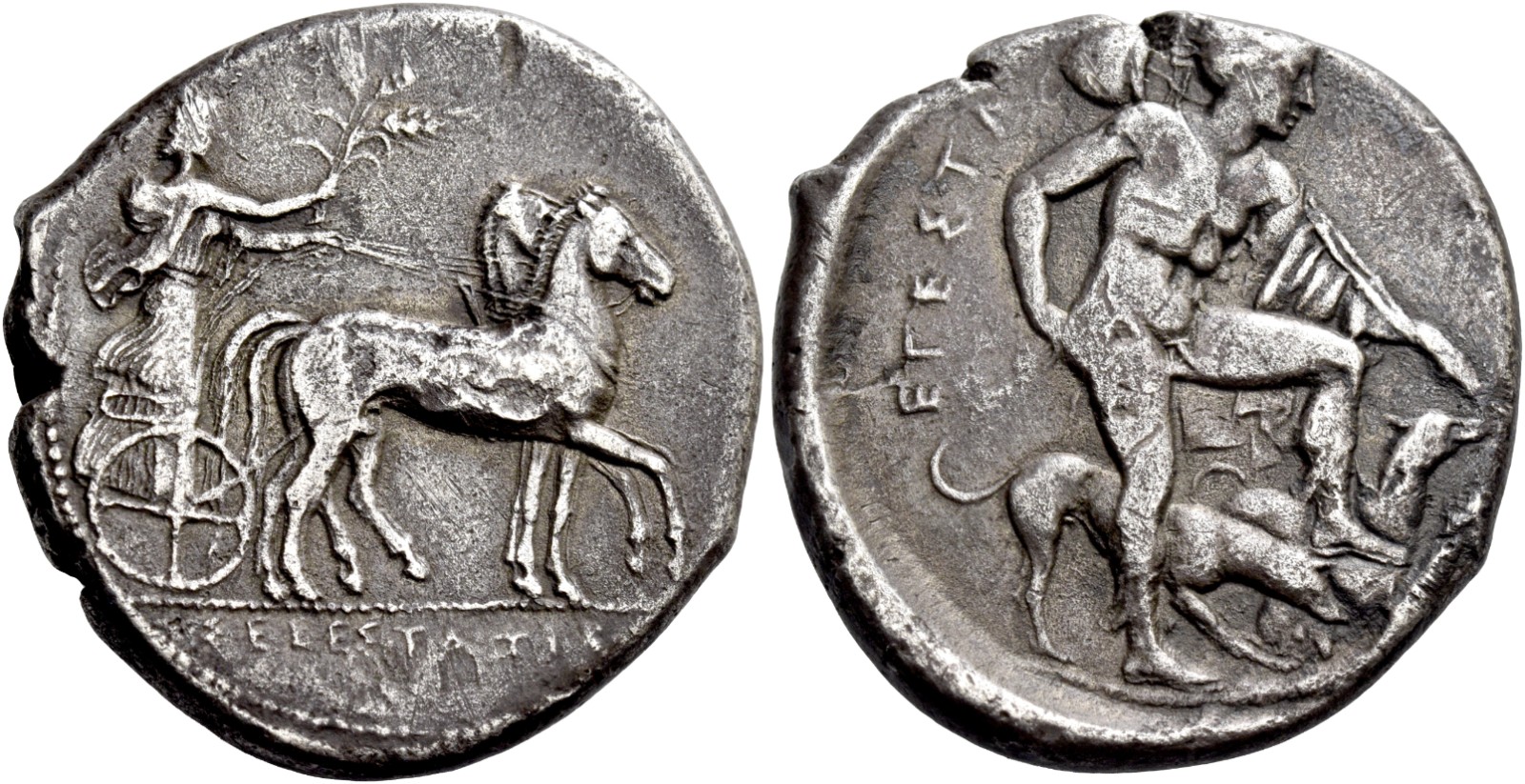Segesta, silver, tetradrachms (415-410 BCE): Difference between revisions
From SILVER
No edit summary |
m (Callatay moved page S 724 - Segesta, silver, tetradrachms (415-410 BCE) to Segesta, silver, tetradrachms (415-410 BCE)) |
(No difference)
| |
Latest revision as of 04:49, 26 July 2023
415 BCE - 410 BCE Silver 732 kg
Description
| ObverseInscription or printing placed on the obverse.: | EΓΕΣΤΑΙΩΝ or ΣΕΓEΣΤΑZΙΒ (Greek and/or Elymaic).Aegestes, the city's founder, as charioteer, driving slow quadriga r. and holding barley ears |
| ReverseInscription or printing placed on the reverse.: | ΣΕΓ(E)ΣΤΑZΙΒ (Greek and Elymaic).Aegestes, the city's founder, as hunter, standing r. with l. foot upon rock, r. hand resting on hip, l. elbow on knee, he wears a pilos suspended behind the neck, sword hanging from strap around l. shoulder, ankle-boots (cothurni) and chlamys over l. arm, two javelins in l. hand. At his feet, two hounds r. and in r. field, ithyphallic herme l., wearing petasus |
Mint and issuing power
| MintIdentifies the place of manufacture or issue of a numismatic object.: | Segesta | Ancient regionAncient region.: | Sicily | Modern countryModern country: Italy | AuthorityIdentifies the issuing power. The authority can be "pretended" when the name or the portrait of X is on the coin but he/she was not the issuing power. It can also be "uncertain" when there is no mention of X on the coin but he/she was the issuing power according to the historical sources: |
Chronology
| FromIdentifies the initial date in a range assigned in a numismatic context. | 415 BCE | toIdentifies the final date in a range assigned in a numismatic context.. | 410 BCE | PeriodTime period of the numismatic object.: Classical 480-323 BC |
Physical description
| MetalThe physical material (usually metal) from which an object is made.: | Silver |
Median weightMedian of the weights of numismatic objects (in grams). in grams | 16.80 | DenominationTerm indicating the value of a numismatic object. Examples: tetradrachm, chalkous, denarius.: | tetradrachm |
StandardStandard.: |
Image

S 724 - Segesta, silver, tetradrachm, 415-410 BC.jpg [1]
References
| Die study referencePublication of the study: | Lederer 19101Lederer 1910, 1a-3b, Hurter 20082Hurter 2008, p. 131-132, n° T1-T4 | ||
| Coin series referenceReference to coin series study: | HGC 23HGC 2, 1103 | ||
| Coin series web referenceCoin series web references: | |||
Obverse dies distribution
| FrequencyFrequency of specimen in distribution. ᵖ | Number of obversesNumber of obverse dies. ᵖ (o) | % (o) | Number of coinsNumber of coins. (n) | % (n) | Die nameName(s) of the die(s). |
| 5 | 1 | 50 | 5 | 45.45 | 2 |
| 6 | 1 | 50 | 6 | 54.55 | 1 |
| Total | 2 of 2 | 100 | 11 of 11 | 100 |
Reverse dies distribution
no distribution is available
Quantification
| Number of obversesNumber of obverse dies. ᵖ (o) | 2 | Number of singletons (o1)The number of singleton coins. ᵖ | |
| Number of reverse diesNumber of reverse dies. (r) | 3 | Number of coinsNumber of coins. (n) | 11 |
| Coins per obverse dieNumber of coins per obverse die. (n/o) | 5.5 | Coins per reverse dieNumber of coins per reverse die. (n/r) | 3.67 |
| Reverse per obverse ratioRatio of obverse dies divided by reverse dies. (r/o) | 1.5 | Percentage of singletons (o1)number of coins (n) divided by the number of singletons (o1) ᵖ | % |
| Original number of dies (O) (Carter 1983 formula)The estimation of the number of coins according to Carter 1983 ᵖ | 2.18 | Coins struck if 20,000 as average productivity per dieCoins made if the average productivity for obverses (according to Carter) is 20,000. ᵖ | 43,600 |
| Original number of dies (O) (Esty 2011 formula)The estimation of the number of coins according to the singleton formula in Esty 2011 ᵖ (O) | 2.44 | Survival rate if 20,000 as average productivity per dieSurvival rate if average productivity is 20,000. ᵖ | 0.00025 |
| Coverage (o = % of O) (Esty 1984 formula)Esty 1984 - coverage (% of O) ᵖ (o = % of O) | % | Die productivity if survival rate 1/2,000Average productivity if survival rate is 1/2,000. ᵖ | 10,091.74 |
| Weight of silver (in kg) if 20,000 coins per die (O = Carter formula)Carter 1983 * Median weight * 20000 (*10 if gold or electrum) ᵖ | 732 kg <br /> 732 kg | Die productivity if survival rate 1/5,000Average productivity if survival rate is 1/5,000. ᵖ | 25,229.36 |
Remarks
Most likely one single workstation